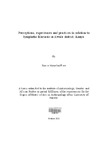| dc.description.abstract | Perceptions experiences and practices in relation to lymphatic filariasis were explored in three endemic sub-locations of Vanga in Kwale District in the Kenyan Coast. Both quantitative and qualitative methods of data collection were used in this study. Two hundred and fifty four respondents were interviewed using structured questionnaires. In addition 21 Key Informants Interviews and 5 Focus Group Discussions were held. The findings revealed that people in the endemic areas knew about lymphatic filariasis and could describe the overt clinical signs of the disease and assigned them local· terminologies.
The perceived causes of lympbatic filariasis in this area included mosquitoes which was the most common answer amongst respondents. Other causes mentioned included sex, witchcraft, foods like COCOIDlts, weak immune system, dirty water. inheritance, filarial doze and fate. However, most respondents and discussants believed in the duality of causes of this disease arguing that a combination of factors led to this disease, The experiences of people suffering from this disease ranged from disbelief to resignation to their fate.
Manifestations of this disease has subjected people with lymphatic filariasis to stisma both self and inflicted, teasing, unsuitability/discrimination in marriage, sexual dysfunction and abandonment sometimes leading to divorce. The practices for management of lymphatic filariasis are varied depending on the stage of the disease. The health seeking behaviour involved popular sector, folk sector and professional sector. The diagnosis of lymphatic filariasis is often delayed and in most cases depends on the overt clinical signs.
The treatment can sometimes be harmful to those suffering from the disease. Some treatment options used by the patients included piercing of the hydrocele sack to release fluids using bicycle wires or draining using syringes among others. Most of those suffering from lymphatic filariasis are taken care of by their families and maintain a high level of personal hygiene and also massage the affected areas. Due to corrective surgery through hydrocelectomy most of the respondents now believe that hydrocele can be cured.
In conclusion Lymphatic filariasis in Kenya has persisted due to the local perception on the causes and transmission of the disease. The manifestations of the disease and experiences of those suffering from it has perpetuated their suffering and stigmatization.
Special emphasis on the management of the disease in conjunction with better diagnosis. Qre. and treatmeat methods should be adoJ*ld by the to prevent the overt clinical signs of this disease. In order lD eradicate lymphatic fiJariasis, understanding communities' perceptions of the cau_ manifestation and treatment of the disease should be put into consideration wbile designing local campaigns on awareness and distribution of mass drug therapy. | en_US |

